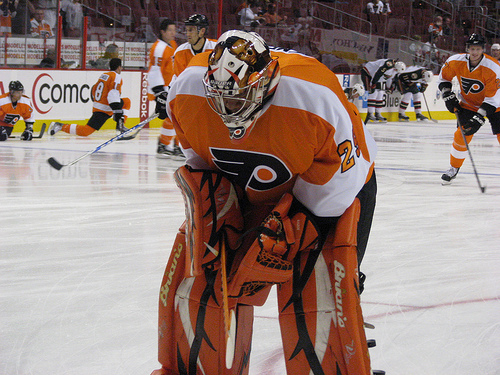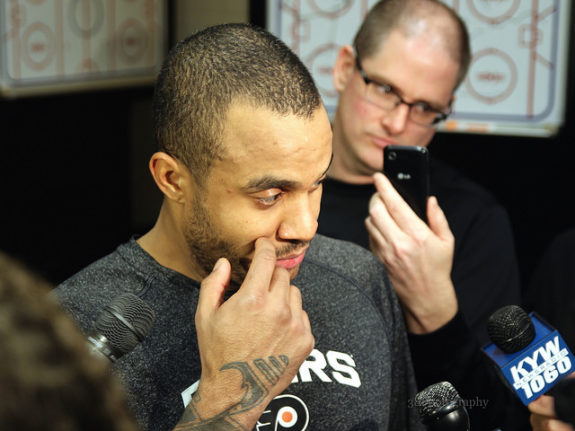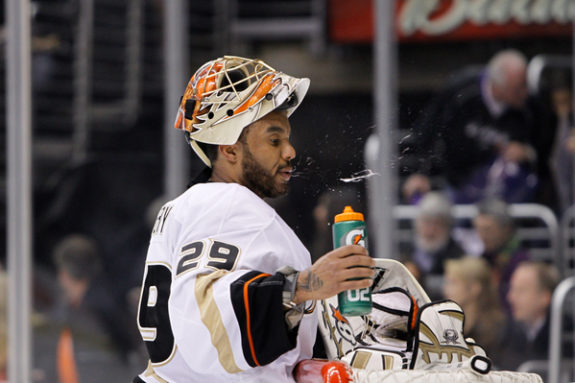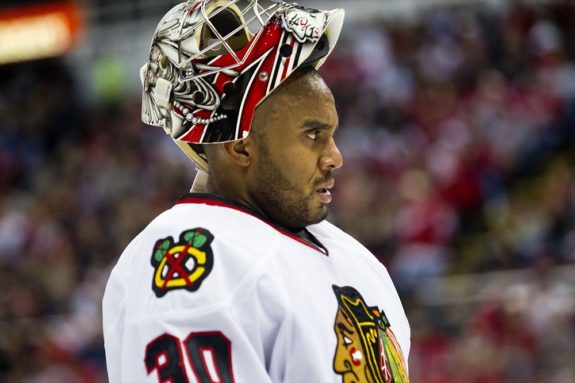Ray Emery was no ordinary NHL goaltender. He had a big personality. He was a fighter. On July 15, the hockey world was shocked to learn of Emery’s passing, at just 35 years old. Swimming with friends early on Sunday morning, Emery jumped into the water and didn’t come up. Hamilton Police labeled the incident a “case of misadventure” and no foul play is expected.
A great teammate, friend, and well-respected opponent. The hockey community remembers the infectious personality and incredible skill of Ray Emery: https://t.co/6UOo5eKuWU pic.twitter.com/YIlAO2H15S
— NHLPA (@NHLPA) July 16, 2018
The Hamilton, Ontario native spent 11 years in the NHL, playing for the Ottawa Senators, Philadelphia Flyers, Chicago Blackhawks and Anaheim Ducks. While rarely capturing the starting job, Emery collected an impressive record of 145-86-28, including 16 shutouts. He also added 79 penalty minutes. During his time in the NHL, Emery was a colorful, entertaining player to watch both on and off the ice. While he was viewed as a fighter and a troublemaker, he even had a tattoo on his arm saying “Anger is a Gift,” Emery was a remarkable player with an equally remarkable journey through his career.
Getting to the NHL
Growing up, Emery loved all things sports. He played baseball, basketball, golf, soccer, and hockey, not choosing one over the other. He described his time playing hockey as “playing for fun.” He was also a very bright student, at one point wanting to become an architect to design houses. Playing hockey as a young kid, the team Emery was playing defense on didn’t have a goaltender so he volunteered at age nine.
With the potential of a scholarship in mind, Emery’s parents had him choose what route he wanted to take and focus on that. He chose hockey and was cut from the first eight teams he tried out for. Ready to quit, Emery hit the golf course and met a man named Ron Batenburg, the general manager of the Junior C Dunnville Terriers. Batenburg was impressed by Emery’s golf game and then found out he played hockey, inviting him to try out for the team.
It took Batenburg a month-and-a-half to convince the young Emery before he reluctantly agreed, being pushed by his parents to go for it as well. He made the team, winning three of 22 games that year with a 6.36 goals against average. Although the stats don’t show it, Emery was excellent for the team. He won rookie of the year and garnered the attention of the OHL.

The Sault Ste. Marie Greyhounds took a chance on him in the 1999 OHL Draft, taking him in the fifth round. He started out the year in Junior before getting called up halfway through the year, leading the team to the conference finals. “He had the eye of the tiger, this guy,” said then-coach Paul Theriault. “He was very combative and very intelligent and he loved to play. And he loved to fight.”
Emery’s temper became well known in his time with the Greyhounds. He had seven fights over his OHL career and opposing teams would try to use that to their advantage to get under the goalie’s skin. This was usually in the form or a racial slur, which although Emery said he was “desensitized to it, ” led to fights throughout his career.
In his first full season with the Soo, Emery was named team MVP and playoff MVP. After being cut from the first eight junior teams he had tried out for, Ray Emery had the attention of the NHL. In the 2001 NHL Entry Draft, the Ottawa Senators selected Emery in the fourth round, 99th overall. The team was deep in goaltenders, so Emery remained with the Greyhounds for a second full season, winning OHL and Canadian Hockey league goalie of the year.
His stellar performance earned him a promotion to the AHL’s Binghamton Senators where in his first year he was named to the All-Star team and was the team’s MVP once again. His fighting continued, with another seven fights through his AHL career. The team ended up sending Emery to anger management.
In the 2005-06 season, Emery cemented himself as the backup netminder, behind future-Hall-of-Famer Dominik Hasek. During the 2006 Olympics, Hasek went down with a groin injury and Emery was handed the reigns.
Emery’s NHL Journey
Ottawa Senators
Emery remained the starter for the rest of the 2005-06 season, including winning one round in the playoffs as a rookie. He also set the record for most straight wins to start a career (nine) and tied Bernie Parent for most wins in a calendar month in March that season (nine).
Emery didn’t have the team’s confidence yet, though. That summer they signed free agent Martin Gerber to a three-year deal. But Gerber struggled early in the season, throwing Emery back into the net. He helped the Senators to their best ever year, reaching the Stanley Cup Final before falling to the Anaheim Ducks in five games.

Emery’s fearlessness was always on display, both on and off the ice. In the dressing room, the team found a dead cockroach on the floor. Teammates began betting Brian McGratton to eat it, but he backed down. Emery took the bet, ate the cockroach and collected $500 from captain Daniel Alfredsson for his efforts.
Even with the success Emery and the Senators had on the ice, the two had a rocky relationship. During the playoffs in May 2007, Ottawa was up 3-1 in the series versus the New Jersey Devils. With the team plane waiting on the tarmac, Emery was late and rushing to the plane. He was involved in a three-car accident, due to his reckless driving. Once Emery was over an hour late to the airport, the team left without him, forcing him to fly commercial later that day. The next day, with no discipline to Emery, the Senators won the series with their tardy netminder in goal.
“If you have a little controversy, it adds to the game. The bottom line is it’s entertainment. Even if there are some guys you don’t like – like Terrell Owens – it’s interesting to see the reaction people have to him, even if they are complaining about him.” – Ray Emery on his contstant controversy
Emery missed the start of the next season, recovering from wrist surgery from the long playoff run. When he returned, the club stuck with Gerber in net, which did not impress the goalie who led the team to the Stanley Cup Final the year before. It was reported that Emery smashed his stick during a practice and threw it into the stands. That season went from bad to worse for Emery, who fought teammate heavyweight McGratton in practice and was sent home from a practice after showing up five minutes before it was to start. Then general manager Bryan Murry made it known that Emery would not return the following year and bought him out at year-end.
Philadelphia Flyers & Anaheim Ducks
After a one-year stint with the KHL’s Atlant Moscow, Emery signed a one-year deal with the Philadelphia Flyers in 2009-10. In early December, he was placed on injured reserve to have surgery on a torn muscle in his abdomen. Originally expected to be sidelined for six weeks, it was discovered that Emery had avascular necrosis in his hip, which is the death of bone tissue. The disease was made famous by NFL and MLB player Bo Jackson and in most cases, would be career-ending.
Emery’s fighting attitude was on full display through his recovery, and luckily the disease was caught early. Doctors removed 13 centimeters of his right fibula, then grafting it to the femur. It’s an extremely complex surgery and while it was successful, there was no timetable for his return to hockey.
The Flyers announced Emery was done for the year, ending his first stint with Philadelphia. He returned from 2013-15 as a backup to Steve Mason.

By January 2011, Emery was skating again. In February, the Anaheim Ducks took a chance on the goaltender, assigning him to an AHL conditioning stint with the Syracuse Crunch. He went 4-1-0, with a 1.98 GAA and .943 save percentage. The Ducks called him up and Emery continued to impress, winning his first six starts and leading the team to the playoffs. Emery was nominated by the team for the Bill Masterton Memorial Trophy, and he was one of three finalists for the award that year.
Chicago Blackhawks
Emery had terrific runs through his career, from the streak at the beginning of his career to the return from his hip surgery. But his time with the Chicago Blackhawks may have been his best. In the 2011-12 season, Emery went 15-9-4, including 10-0-3 at home. That season, he was once again nominated for the Bill Masterton Memorial Trophy.

The following season, the club brought him back. He started the season with 10 straight wins, becoming the first NHL goalie to do so. He ended up winning his first 12, and finished the year 17-1-0, including a span that included three shutouts over five games. One of his games included a miraculous 45-save performance versus the Calgary Flames. Chicago went on to win the Stanley Cup that year, with Emery hoisting the trophy as the team’s back-up. That year, Emery and Corey Crawford shared the William Jennings Trophy as the goaltenders with the fewest goals scored against.
After his NHL career was over, Ray Emery played for the Ontario Reign and the Toronto Marlies in the AHL. He was largely brought in as a mentor to the younger players, as a veteran of the NHL. He also spent one year in Germany with the Mannheim Eagles.
The Lasting Impact of Ray Emery
Emery always knew where he came from. When he won the Stanley Cup with Chicago, one of the first things he did was call Kathrine Hedley, the secretary for Cayuga and District Minor Hockey where Emery first played. He wanted to bring the Cup to Cayuga so the kids there could see the Cup and get to meet him. Even up to the night before he passed away, Emery was giving back to the community, taking part in a charity hockey game.
His death resulted in a flood of responses on Twitter. From teammates to fans, from media to general managers, the impact that “Sugar Ray” had on the NHL is resounding. Even those who never played with the goaltender recounted stories of playing against him or watching him play. Toronto Maple Leafs general manager Kyle Dubas tweeted out a message describing his experiences with Emery from their time together in Sault Ste. Marie to the Toronto Marlies. Many young Leafs tweeted saying how much of a mentor the goaltender was to them.
On the passing of Ray Emery… pic.twitter.com/aR17IBFE0d
— Kyle Dubas (@kyledubas) July 15, 2018
Even through his rough patches with the Senators, the goaltender was always known as an extremely loyal teammate and tremendous competitor. From being cut by the first eight teams he tried out for in junior hockey, Emery went on to become an NHL record holder and a William Jennings Award winner. After a potentially career-ending disease, he came back to win a Stanley Cup. Where others may have quit, he continued battled back. Ray Emery will always be remembered as a fighter.